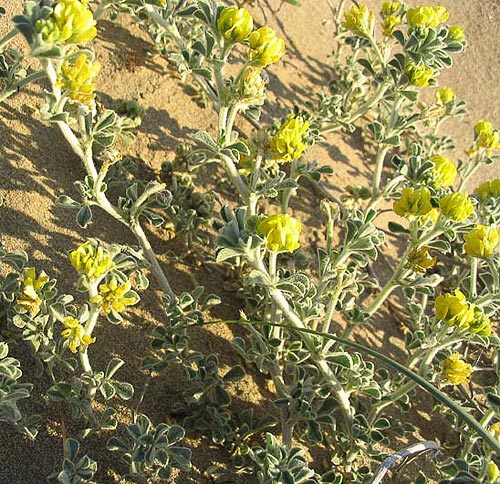Relatives
Medicago marina L. - Sea Medick.
Taxonomic position.
Family Fabaceae Lindl., genus Medicago L.Morphology and biology.
Perennial herbaceous densely white-tomentose plant. Rhizome strong. Stems numerous from one root, 10-30 cm tall, decumbent or ascending, often branched, especially at the base. Subterranean parts of the stems long and slender. Stipules ovate-lanceolate, acute, usually entire. Leaflets ovate-cuneate, dentate in upper part. Raceme dense, of 5-20 flowers, head-shaped, on firm stalk. Corolla citrine-yellow. Pod twisted 2-4 times, 5-6 mm diameter, densely pubescent, with short prickles, tubercles or less often unarmed. Flowers in June, fruits in July. Autogamous plant. 2n=16.Distribution.
Crimea, Black Sea coast of the Caucasus.Ecology.
On coastal sands and shingles.Economic value.
May be successfully used for sand fixing in coastal zone.References:
Vassilchenko IT. 1949. Medick, the best forage plant. In: Acta Inst. Bot. Acad. Sci. URSS. Ser.1. V.8. Leningrad. P.7-240.Goncharov PL., Lubenets PA. 1985. Biological aspects of medick cultivation. Novosibirsk: Nauka. 253 p. (In Russian).
Grossheim AA. 1945. Medick - Medicago L. In: Shishkin BK., ed. 1945. Flora URSS. V.11. P.129-176. (In Russian).
Grossheim AA. 1952. Flora of Caucasus. 2nd ed. V.5. P.177-192. (In Russian).
Sinskaya EN. 1950. Medick. In: Cultivated flora of the USSR. V.13, No.1. P.7-344. (In Russian).
Vassilchenko IT. 1987. Medick - Medicago L. In: Fedorov AA., Tzvelev NN., eds. Flora of the European part of the USSR. V.6. P.187-195. (In Russian).
Lesins KA., Lesins I. 1979. Genus Medicago (Leguminosae). A taxogenetic study. 228 p.


